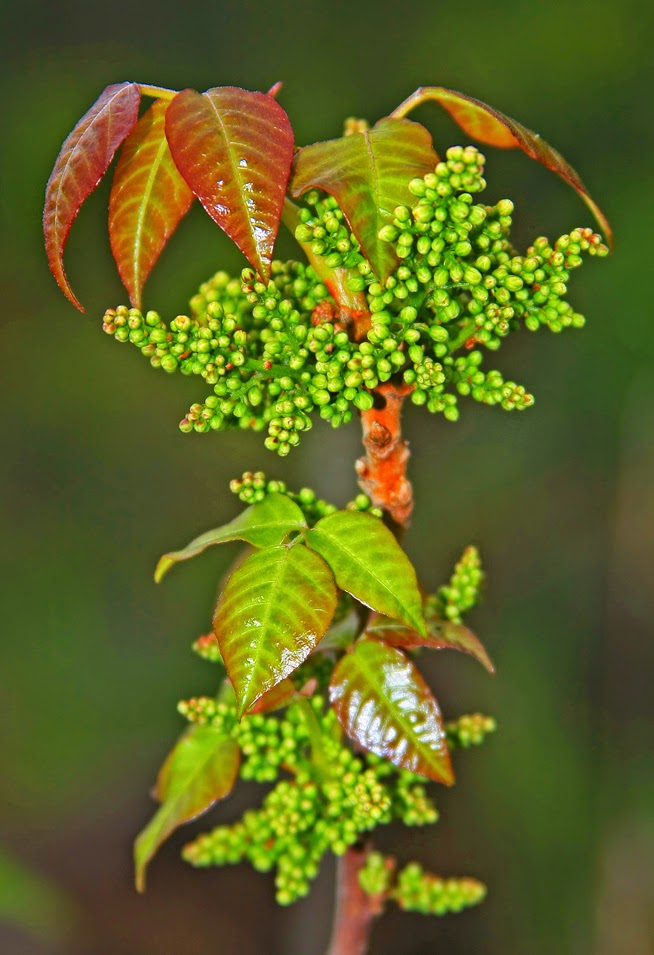The tenth began as an extremely foggy morning with the sun finally beginning to burn through at about 9:30AM. As the sun made its appearance, the temperature rose quickly causing me to shed a couple of layers of clothing. A view out towards the Gill Hodges-Marine Parkway Bridge depicts the fog as it dissipated.
Heading east through the brush, there are several spots that appear to be completely undisturbed by human activity. Here we see the back-side of the dunes at the extreme eastern end of the cove that fronts the marsh.
This view looks west along the cove, with the marsh situated where the shore-line curves inwards towards the center of the image. Compare the clear blue skies to the first image in this post to see just how much things cleared up; the time was about 11:00 AM.
The marsh is often full of Warblers in the spring, and on this day I managed to get some good images of a Chestnut-sided Warbler, which, according to Tony is the first time this species has been seen in the marsh. This one appears to be a male in full breeding plumage.
Fairly common residents of the marsh and the surrounding woods include the Mourning Dove...
... and the White-throated Sparrow.
On the 10th of May, the most numerous bird species was the Grey Catbird, with dozens spotted flitting through the woods.
The following Saturday, May 17th, saw NPS Volunteers Genie and her children, Becky and Danko, making observations in the marsh. While Genie made notes and collected samples, the remarkably devoted youngsters did some clean-up of man-made debris.
Meanwhile, along the beach, Horseshoe Crabs have returned for their annual rites of reproduction. Here we see a couple, caught in the act, with the typically much smaller male atop the female.
All along the beach several other couples were observed, as were their tracks. This rather confused Horseshoe Crab trail was left in the sand.
Horseshoe Crabs are tracked by government agencies, using white-painted metal disks attached to their carapace. This example, numbered 780371, was found along the beach just outside the marsh’s entrance.
Also seen on the beach were many, many Semi-palmated Sandpipers, including this group. In some situations they can be confused with Sanderlings, although a close look will reveal the variety in their plumage; this is not seen on Sanderlings.
On May 24th, Michael Christopher, from NYC Audubon, returns along the beach-front while conducting his migratory bird-count. Michael has been doing this for several years and has a good handle on trends in the area surrounding the marsh. On this day, he noted the paucity of species. The following week he counted a group of over 300 Semi-palmated Sandpipers, the largest number he’d ever seen at this location.
Five Semi-palmated Plovers pose for the camera while foraging in the marsh. There were more than a dozen of these small plovers ranging inside and outside of the marsh on May 31st.
One of my favorite shore-birds, the Ruddy Turnstone, is often seen as an individual amongst a larger group of other shore birds. On May 31st, there were more than a dozen in the area, concentrating on the far East end of the cove where the marsh is situated.
This pair of Least Terns take a break in foraging along the shore, immediately in front of the marsh, on May 24th. Very similar in appearance to the Common Tern (see next image), they are smaller, have differently-colored mandibles and feature a small triangular patch of white between their eyes.
Also on May 24th, this common Tern perches on a sheet of barnacle-encrusted fiberglass, just outside the marsh. Note his mandibles, which are a deeper red and have more black on the tip than the Least Tern.
The pond inside the marsh hosts all sorts of avian visitors. On May 24th this American Robin decided to stop for a bath in between his other daily survival tasks.
On May 24th, a grey sky greeted me when I came into the marsh. One can see how the marsh is becoming greener as spring takes hold in earnest.
Along with the “greening” of the woodlands within the marsh, flowers also began to add their little spots of color. This flower was photographed on May 24th, inside the woods at the far western corner of the marsh. Unfortunately, it remains unidentified.
Also on the 24th, another plant that caught my eye was this blooming nemesis of all hikers, Poison Ivy. Genie explains that due to deforestation, Poison Ivy flourishes where it normally would not, becoming as common as a weed.
A side trip over to West Beach in mid- April, revealed that the Piping Plovers were hunting for nesting territory.
Several weeks later, this recently hatched chick (one of four observed) was photographed scurrying about.
Although the marsh features a nesting box suited to the Osprey, they appear not to have taken much notice. The Osprey is often seen hunting along the shore next to the marsh, or passing overhead with its catch, but is rarely seen in the interior. This “Osprey” is actually a Bell-Boeing MV-22 Osprey belonging to the United States Marine Corps. The MV-22 is a hybrid “tilt-rotor” aircraft, with the vertical landing capabilities of a helicopter and the speed of an airplane. It was photographed on May 31st as part of the Fleet Week visit to New York City over the Memorial Day weekend.
Rocky Point Marsh needs your help. To volunteer for service contact National Park Services Ranger Tony Luscombe at: dcalato6@gmail.com
For more photos of Rocky Point as well as other locations within the Gateway NRA complex, visit: www.frankdesisto.com
Text & Photographs by Frank V. De Sisto























